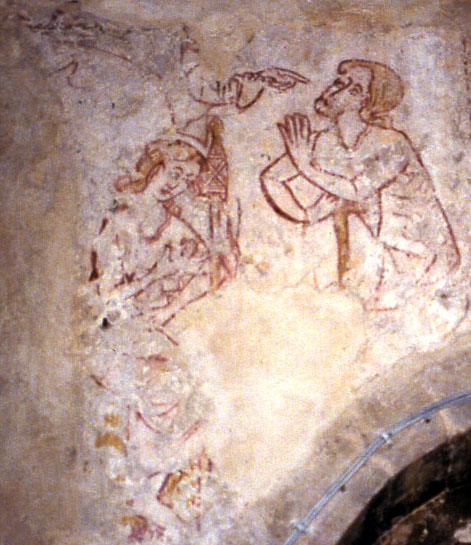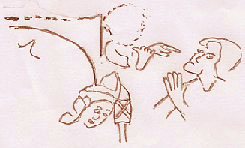Bledlow, Buckinghamshire (†Oxford) c.1300
Adam Delving & Eve Spinning (with the Expulsion?)

This intriguing painting is over the south door at Bledlow. At the right, Adam, right hand on his spade handle, has been interrupted in his delving. A seated Eve at the left spins with a very clear distaff.
There are a number of unusual features (insofar as it is possible to say what is usual for this rare subject). The source of the interruption is shown above at the left of the photograph. Tristram described the details in this area as “a Manus Dei, with the index finger pointing towards Adam”, which is essentially true, but there is more. In fact, two hands are visible, one pointing to Adam, and the other apparently gesturing with an extended thumb backwards towards the implied owner of the hands, part of whose upper torso is also visible (the head is virtually obliterated). This is presumably God (or, much less likely, I think) his angelic messenger.

The drawing at the left might help, because close scrutiny also reveals the corner of a tall rectangular building or wall, directly behind Eve’s head, with the wide opening of a round arch set in it below. I think this is the gate of Eden; some faint details within the arch may have belonged to the ‘flaming sword which turned every way’ of Genesis 3:24, or one of the ‘Cherubims’ also mentioned in the verse.
If this is so, God’s backwards-indicating thumb may be taken to demonstrate to Adam that there is no possibility of a return to Eden. In the language of gesture this might seem to us overly demotic or colloquial for the hand of God, but the Bledlow painter, whose assumptions about decorum were neither ours nor those of the codified repertories emerging a century after his day, might have thought otherwise. Similarly, incongruous as the idea of God leaning out of a window or opening in a wall might seem, it might nevertheless be what the painter intended, although another possibility is that he is simply emerging from a cloud, as is common enough in medieval art.
These details are I think an abbreviated reference to the Expulsion itself, although it remains quite possible that a separate Expulsion was painted elsewhere in the church, perhaps somewhere to the left of this Delving and Spinning.
A final interpretative point concerns Eve. She is not in fact holding the distaff; her left arm is bent and her left hand lies in her lap while her right is held on her breast, and I think this is because she is cradling and feeding a baby.¹ There is a suggestion of a very small head just to the right of Eve’s right thumb, and some details lower down near her waist level which might be swaddling clothes. Paintings of the Virgin (the ‘second Eve’) suckling the Christ Child at Beckley and Faversham are worth comparing, and if this is a baby, then Cain, first born after the Fall, is the most likely candidate.¹
The other surviving paintings at Bledlow are much less easy to see – a St Christopher over the north door, with only the Hermit really clear now, and the very faint remnants of a Doom over the chancel arch. But this one is by far the most interesting of the three.
Website of Holy Trinity, Bledlow
¹ There is a detail of Eve suckling Cain in the 9th century Moutier-Grandval Bible, made at Tours in France. Beyond Eve and Cain, Adam breaks up the ground with a mattock. British Museum Add. Ms. 10546, fol. 5v. (illustration in John Beckwith, Early Medieval Art, Thames & Hudson, 1964, pl.46)
† in page heading = Diocese